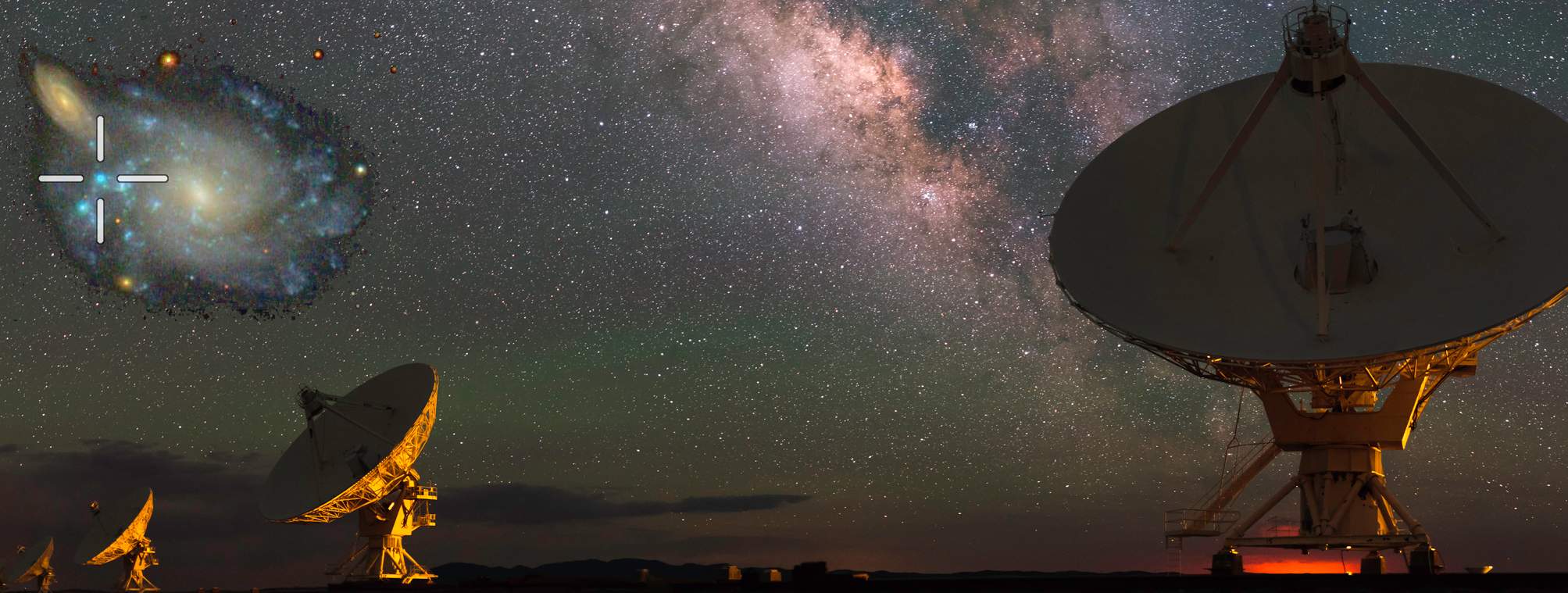
Caltech-NRAO Stripe 82 Survey: Pilot
Data can be accessed from the CNSS Pilot Interactive Data Access webpage.
See LORVASTS for a regularly-updated compilation of radio transient surveys.
Abstract: We have commenced a multi-year program, the Caltech-NRAO Stripe 82 Survey (CNSS), to search for radio transients with the Jansky VLA in the Sloan Digital Sky Survey Stripe 82 region. The CNSS will deliver five epochs over the entire ∼270 deg2 of Stripe 82, an eventual deep combined map with a rms noise of ∼40 μJy and catalogs at a frequency of 3 GHz, and having a spatial resolution of 3". This first paper presents the results from an initial pilot survey of a 50 deg2 region of Stripe 82, involving four epochs spanning logarithmic timescales between one week and 1.5 years, with the combined map having a median rms noise of 35 μJy. This pilot survey enabled the development of the hardware and software for rapid data processing, as well as transient detection and follow-up, necessary for the full 270 deg2 survey.
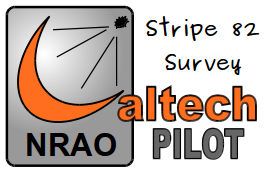 Data editing, calibration, imaging,
source extraction, cataloging and transient identification were completed in a semi-automated fashion within
six hours of completion of each epoch of observations, using dedicated computational hardware at the NRAO in
Socorro, and custom-developed data reduction and transient detection pipelines. Classification of variable and
transient sources relied heavily on the wealth of multi-wavelength legacy survey data in the Stripe 82 region,
supplemented by repeated mapping of the region by the Palomar Transient Factory (PTF). 3.9+0.5
-0.9% of the few
thousand detected point sources were found to vary by greater than 30%, consistent with similar studies at 1.4
GHz and 5 GHz. Multi-wavelength photometric data and light curves suggest that the variability is mostly
due to shock-induced flaring in the jets of AGN. Although this was only a pilot survey, we detected two bona
fide transients, associated with an RS CVn binary and a dKe star. Comparison with existing legacy survey
data (FIRST, VLA-Stripe 82) revealed additional highly variable and transient sources on timescales between
5--20 years, largely associated with renewed AGN activity. The rates of such AGN possibly imply episodes
of enhanced accretion and jet activity occurring once every ∼40,000 years in these galaxies. We compile the
revised radio transient rates and make recommendations for future transient surveys and joint radio-optical
experiments.
Data editing, calibration, imaging,
source extraction, cataloging and transient identification were completed in a semi-automated fashion within
six hours of completion of each epoch of observations, using dedicated computational hardware at the NRAO in
Socorro, and custom-developed data reduction and transient detection pipelines. Classification of variable and
transient sources relied heavily on the wealth of multi-wavelength legacy survey data in the Stripe 82 region,
supplemented by repeated mapping of the region by the Palomar Transient Factory (PTF). 3.9+0.5
-0.9% of the few
thousand detected point sources were found to vary by greater than 30%, consistent with similar studies at 1.4
GHz and 5 GHz. Multi-wavelength photometric data and light curves suggest that the variability is mostly
due to shock-induced flaring in the jets of AGN. Although this was only a pilot survey, we detected two bona
fide transients, associated with an RS CVn binary and a dKe star. Comparison with existing legacy survey
data (FIRST, VLA-Stripe 82) revealed additional highly variable and transient sources on timescales between
5--20 years, largely associated with renewed AGN activity. The rates of such AGN possibly imply episodes
of enhanced accretion and jet activity occurring once every ∼40,000 years in these galaxies. We compile the
revised radio transient rates and make recommendations for future transient surveys and joint radio-optical
experiments.
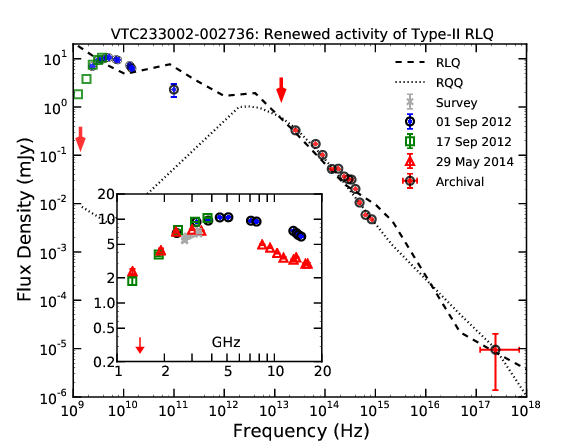
The multi-frequency continuum spectrum of VTC233002-002736, a known optical quasar and a new class of AGN discovered in the CNSS Pilot survey to have renewed jet activity. Archival photometry is shown as filled red circles, and the 3σ upper limit at 1.4 GHz from the FIRST survey from 1999 shown as a red arrow. The source is GPS in the follow up observations from 2012 (blue circles and green squares) and 2014 (red triangles), likely indicating a young jet. Spectra for radio-loud and radio-quiet quasars are also shown for guidance, and indicate that VTC233002-002736 may represent a source transitioning from the radio-quiet to the radio-loud phase. The inset shows the zoom-in of the radio continuum spectra from our three epochs.

Above the limiting magnitudes of our radio and optical surveys (S=0.5 mJy and R=21 mag), we find little overlap between optical variables and radio variables. This Venn diagram (not to scale) shows the number of persistent as well as variable optical sources from PTF and radio sources from our point source catalog (PSC). Only 0.2% of the optical persistent sources have counterparts in the PSC, while 22% of the PSC radio sources have optical counterparts in PTF. Among the cataloged sources, 3.4% display optical variability, while 3.9% display . Only 42 radio sources have optical variable counterparts among the sample of 3652, while only two of these are variable also in the radio.
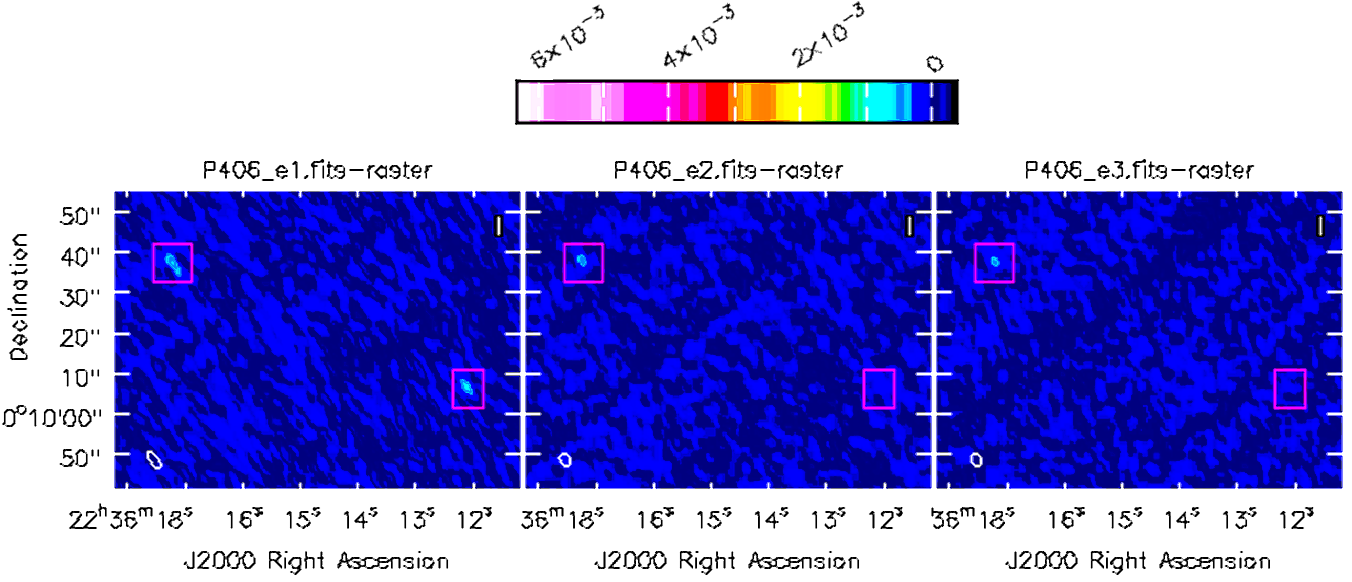
An RS CVn binary system flaring at ∼1 mJy discovered as a radio transient in the CNSS Pilot survey. The radio image cutouts at the location of the transient (VTC223612+001006) from the first three epochs of the pilot survey are shown here. A comparison 0.5 mJy persistent source (upper right corners of the cutouts) is also highlighted. The colorbar has units of Jy.
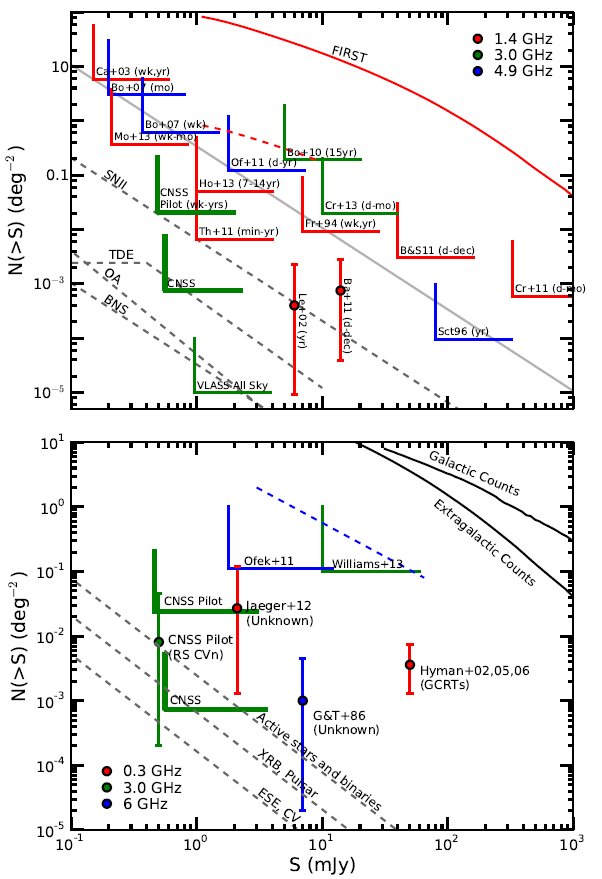
The superior part of the phase space of slow extragalactic (top) and Galactic (bottom) transients probed by the Caltech-NRAO Stripe 82 Survey. Upper limits to the transient rates from previous radio surveys (colored wedges; 95% confidence), the rates derived from radio transient detections (2σ errorbars), the expected transient rates (dashed gray lines), and persistent source counts (solid curves) are shown for guidance. Using estimated rates for optical and radio transients, we find that the false positive foreground for future EM-GW searches is lower in the radio than in the optical.